Marketing Strategies for Pepsi Beverage Products: A Detailed Report
VerifiedAdded on 2020/02/05
|13
|2885
|123
Report
AI Summary
This report provides a comprehensive analysis of Pepsi's marketing strategies for its beverage products. It begins with an introduction to marketing management and the importance of segmentation, targeting, and positioning. The report identifies a specific customer segment (young adults aged 12-28) for Pepsi's beverage products, focusing on demographic characteristics such as age and income. It then explores the relationship between the marketing mix (product, price, place, promotion, physical environment, process, and people) and the characteristics of the chosen segment. The report examines how Pepsi utilizes various marketing strategies, including online marketing, social media promotion, and collaborations with fast-food chains, to reach its target audience. The analysis also covers Pepsi's pricing strategies, distribution channels, and efforts to maintain a strong brand image. The report concludes by highlighting the effectiveness of Pepsi's marketing mix in satisfying customer needs and improving overall sales and performance. The report underscores the importance of adapting marketing strategies to the preferences and lifestyles of the target demographic to drive sales and brand loyalty. This assignment is available on Desklib, which provides a wealth of past papers and solved assignments to help students excel.
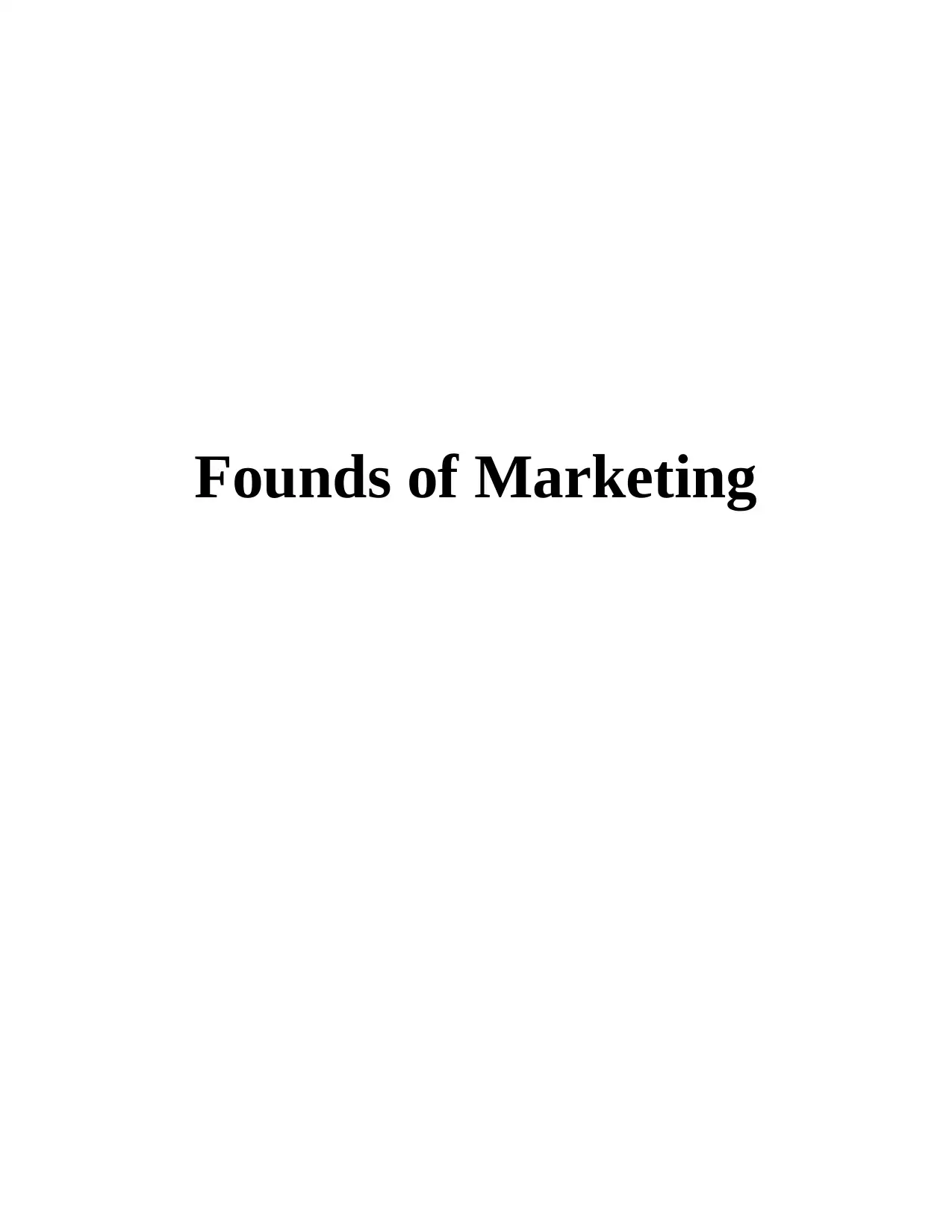
Founds of Marketing
Paraphrase This Document
Need a fresh take? Get an instant paraphrase of this document with our AI Paraphraser
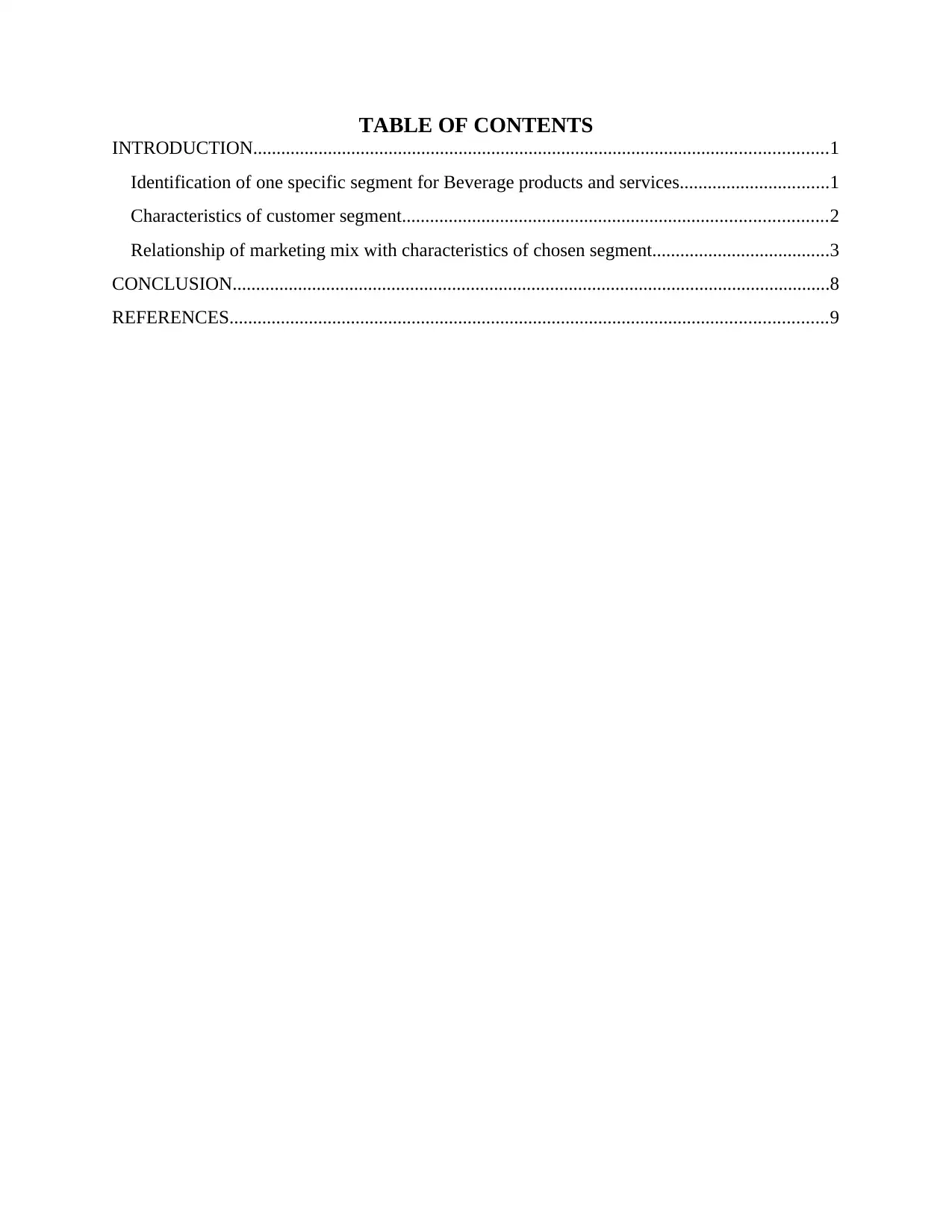
TABLE OF CONTENTS
INTRODUCTION...........................................................................................................................1
Identification of one specific segment for Beverage products and services................................1
Characteristics of customer segment...........................................................................................2
Relationship of marketing mix with characteristics of chosen segment......................................3
CONCLUSION................................................................................................................................8
REFERENCES................................................................................................................................9
INTRODUCTION...........................................................................................................................1
Identification of one specific segment for Beverage products and services................................1
Characteristics of customer segment...........................................................................................2
Relationship of marketing mix with characteristics of chosen segment......................................3
CONCLUSION................................................................................................................................8
REFERENCES................................................................................................................................9
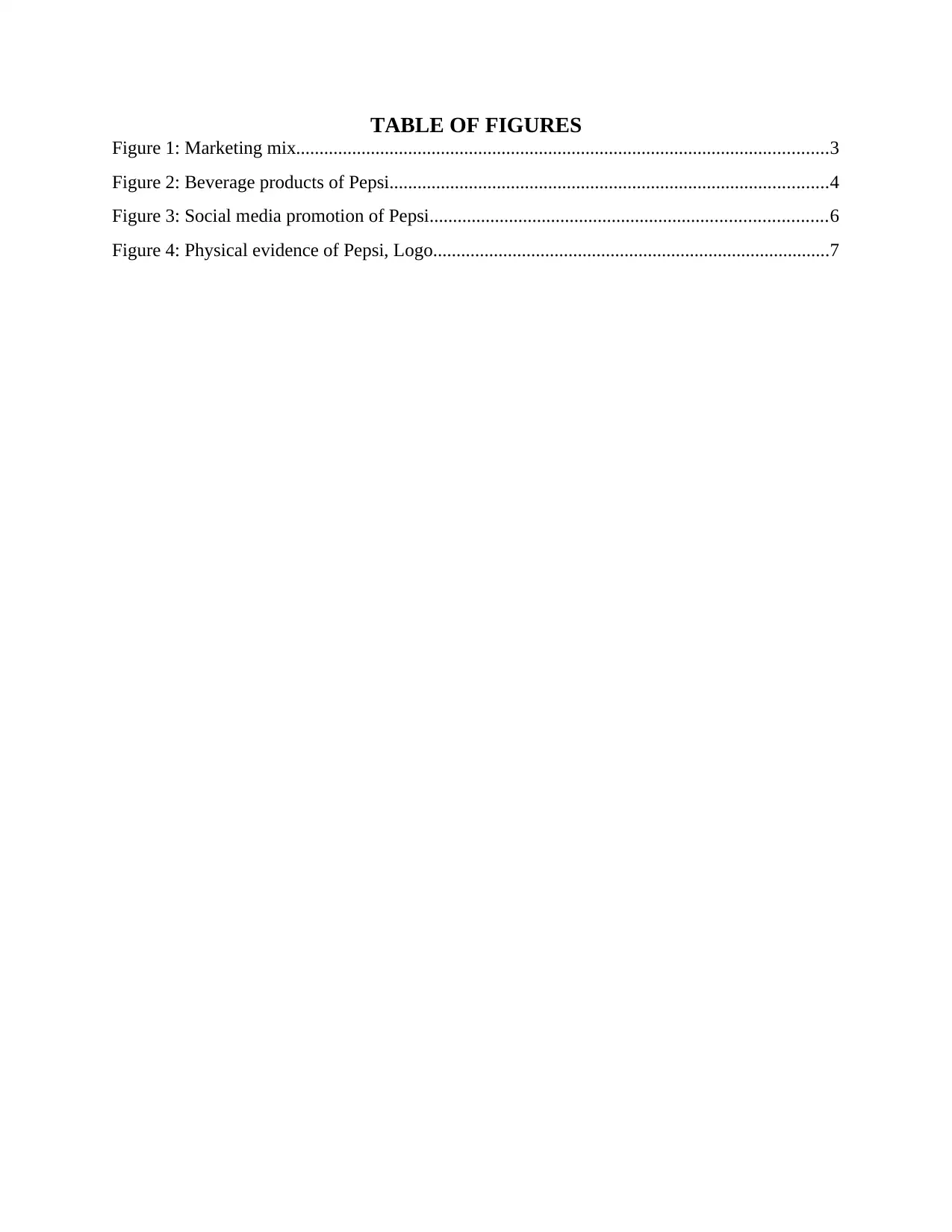
TABLE OF FIGURES
Figure 1: Marketing mix..................................................................................................................3
Figure 2: Beverage products of Pepsi..............................................................................................4
Figure 3: Social media promotion of Pepsi.....................................................................................6
Figure 4: Physical evidence of Pepsi, Logo.....................................................................................7
Figure 1: Marketing mix..................................................................................................................3
Figure 2: Beverage products of Pepsi..............................................................................................4
Figure 3: Social media promotion of Pepsi.....................................................................................6
Figure 4: Physical evidence of Pepsi, Logo.....................................................................................7
⊘ This is a preview!⊘
Do you want full access?
Subscribe today to unlock all pages.

Trusted by 1+ million students worldwide
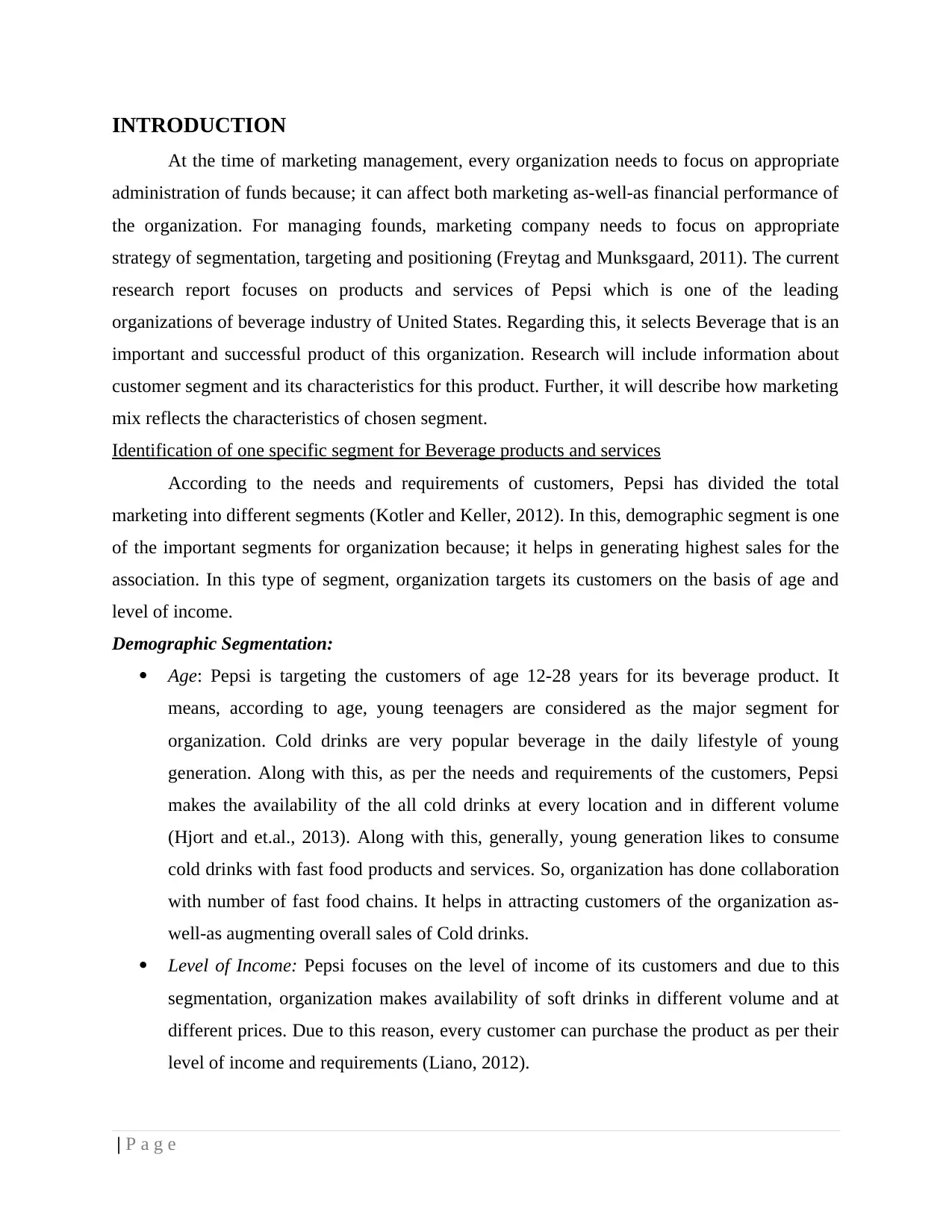
INTRODUCTION
At the time of marketing management, every organization needs to focus on appropriate
administration of funds because; it can affect both marketing as-well-as financial performance of
the organization. For managing founds, marketing company needs to focus on appropriate
strategy of segmentation, targeting and positioning (Freytag and Munksgaard, 2011). The current
research report focuses on products and services of Pepsi which is one of the leading
organizations of beverage industry of United States. Regarding this, it selects Beverage that is an
important and successful product of this organization. Research will include information about
customer segment and its characteristics for this product. Further, it will describe how marketing
mix reflects the characteristics of chosen segment.
Identification of one specific segment for Beverage products and services
According to the needs and requirements of customers, Pepsi has divided the total
marketing into different segments (Kotler and Keller, 2012). In this, demographic segment is one
of the important segments for organization because; it helps in generating highest sales for the
association. In this type of segment, organization targets its customers on the basis of age and
level of income.
Demographic Segmentation:
Age: Pepsi is targeting the customers of age 12-28 years for its beverage product. It
means, according to age, young teenagers are considered as the major segment for
organization. Cold drinks are very popular beverage in the daily lifestyle of young
generation. Along with this, as per the needs and requirements of the customers, Pepsi
makes the availability of the all cold drinks at every location and in different volume
(Hjort and et.al., 2013). Along with this, generally, young generation likes to consume
cold drinks with fast food products and services. So, organization has done collaboration
with number of fast food chains. It helps in attracting customers of the organization as-
well-as augmenting overall sales of Cold drinks.
Level of Income: Pepsi focuses on the level of income of its customers and due to this
segmentation, organization makes availability of soft drinks in different volume and at
different prices. Due to this reason, every customer can purchase the product as per their
level of income and requirements (Liano, 2012).
| P a g e
At the time of marketing management, every organization needs to focus on appropriate
administration of funds because; it can affect both marketing as-well-as financial performance of
the organization. For managing founds, marketing company needs to focus on appropriate
strategy of segmentation, targeting and positioning (Freytag and Munksgaard, 2011). The current
research report focuses on products and services of Pepsi which is one of the leading
organizations of beverage industry of United States. Regarding this, it selects Beverage that is an
important and successful product of this organization. Research will include information about
customer segment and its characteristics for this product. Further, it will describe how marketing
mix reflects the characteristics of chosen segment.
Identification of one specific segment for Beverage products and services
According to the needs and requirements of customers, Pepsi has divided the total
marketing into different segments (Kotler and Keller, 2012). In this, demographic segment is one
of the important segments for organization because; it helps in generating highest sales for the
association. In this type of segment, organization targets its customers on the basis of age and
level of income.
Demographic Segmentation:
Age: Pepsi is targeting the customers of age 12-28 years for its beverage product. It
means, according to age, young teenagers are considered as the major segment for
organization. Cold drinks are very popular beverage in the daily lifestyle of young
generation. Along with this, as per the needs and requirements of the customers, Pepsi
makes the availability of the all cold drinks at every location and in different volume
(Hjort and et.al., 2013). Along with this, generally, young generation likes to consume
cold drinks with fast food products and services. So, organization has done collaboration
with number of fast food chains. It helps in attracting customers of the organization as-
well-as augmenting overall sales of Cold drinks.
Level of Income: Pepsi focuses on the level of income of its customers and due to this
segmentation, organization makes availability of soft drinks in different volume and at
different prices. Due to this reason, every customer can purchase the product as per their
level of income and requirements (Liano, 2012).
| P a g e
Paraphrase This Document
Need a fresh take? Get an instant paraphrase of this document with our AI Paraphraser
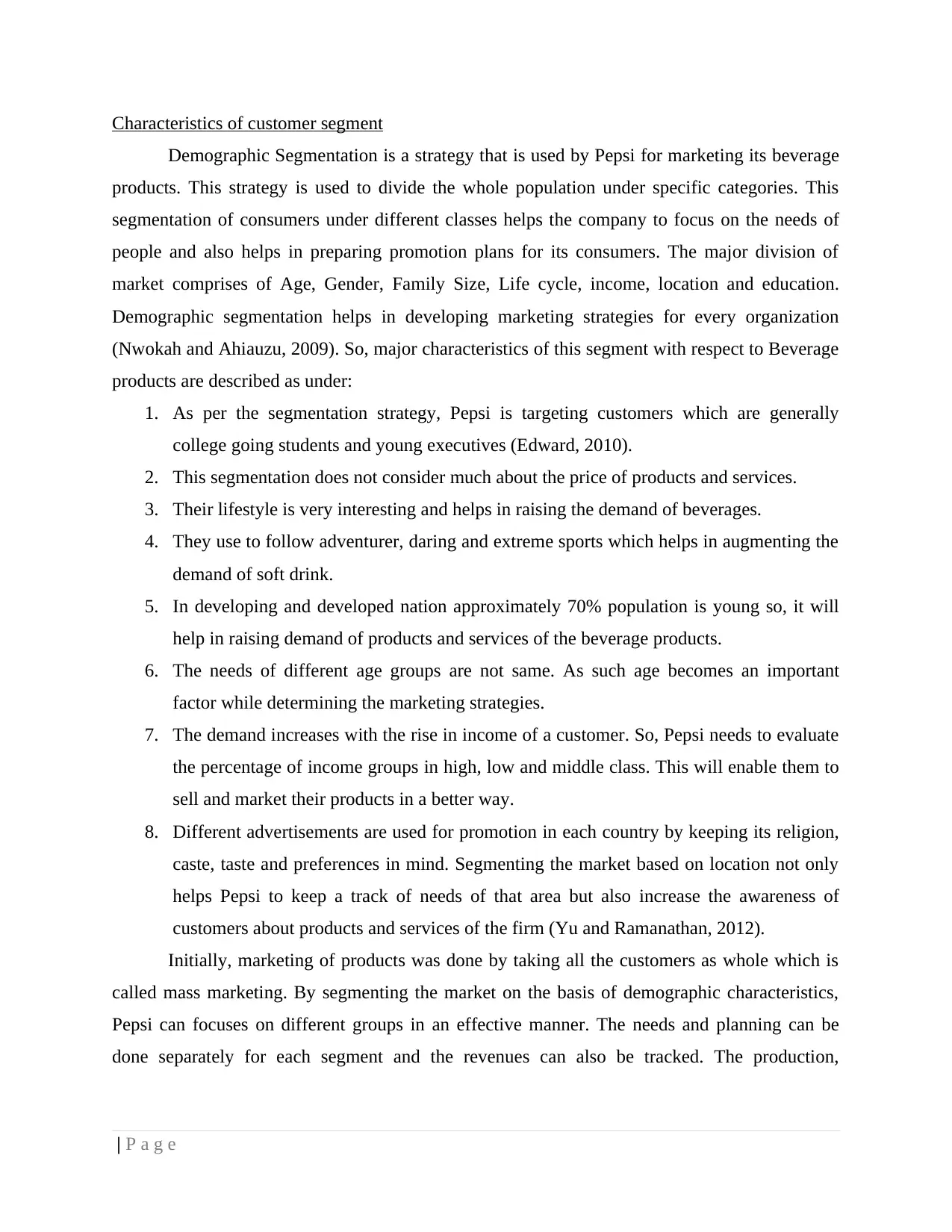
Characteristics of customer segment
Demographic Segmentation is a strategy that is used by Pepsi for marketing its beverage
products. This strategy is used to divide the whole population under specific categories. This
segmentation of consumers under different classes helps the company to focus on the needs of
people and also helps in preparing promotion plans for its consumers. The major division of
market comprises of Age, Gender, Family Size, Life cycle, income, location and education.
Demographic segmentation helps in developing marketing strategies for every organization
(Nwokah and Ahiauzu, 2009). So, major characteristics of this segment with respect to Beverage
products are described as under:
1. As per the segmentation strategy, Pepsi is targeting customers which are generally
college going students and young executives (Edward, 2010).
2. This segmentation does not consider much about the price of products and services.
3. Their lifestyle is very interesting and helps in raising the demand of beverages.
4. They use to follow adventurer, daring and extreme sports which helps in augmenting the
demand of soft drink.
5. In developing and developed nation approximately 70% population is young so, it will
help in raising demand of products and services of the beverage products.
6. The needs of different age groups are not same. As such age becomes an important
factor while determining the marketing strategies.
7. The demand increases with the rise in income of a customer. So, Pepsi needs to evaluate
the percentage of income groups in high, low and middle class. This will enable them to
sell and market their products in a better way.
8. Different advertisements are used for promotion in each country by keeping its religion,
caste, taste and preferences in mind. Segmenting the market based on location not only
helps Pepsi to keep a track of needs of that area but also increase the awareness of
customers about products and services of the firm (Yu and Ramanathan, 2012).
Initially, marketing of products was done by taking all the customers as whole which is
called mass marketing. By segmenting the market on the basis of demographic characteristics,
Pepsi can focuses on different groups in an effective manner. The needs and planning can be
done separately for each segment and the revenues can also be tracked. The production,
| P a g e
Demographic Segmentation is a strategy that is used by Pepsi for marketing its beverage
products. This strategy is used to divide the whole population under specific categories. This
segmentation of consumers under different classes helps the company to focus on the needs of
people and also helps in preparing promotion plans for its consumers. The major division of
market comprises of Age, Gender, Family Size, Life cycle, income, location and education.
Demographic segmentation helps in developing marketing strategies for every organization
(Nwokah and Ahiauzu, 2009). So, major characteristics of this segment with respect to Beverage
products are described as under:
1. As per the segmentation strategy, Pepsi is targeting customers which are generally
college going students and young executives (Edward, 2010).
2. This segmentation does not consider much about the price of products and services.
3. Their lifestyle is very interesting and helps in raising the demand of beverages.
4. They use to follow adventurer, daring and extreme sports which helps in augmenting the
demand of soft drink.
5. In developing and developed nation approximately 70% population is young so, it will
help in raising demand of products and services of the beverage products.
6. The needs of different age groups are not same. As such age becomes an important
factor while determining the marketing strategies.
7. The demand increases with the rise in income of a customer. So, Pepsi needs to evaluate
the percentage of income groups in high, low and middle class. This will enable them to
sell and market their products in a better way.
8. Different advertisements are used for promotion in each country by keeping its religion,
caste, taste and preferences in mind. Segmenting the market based on location not only
helps Pepsi to keep a track of needs of that area but also increase the awareness of
customers about products and services of the firm (Yu and Ramanathan, 2012).
Initially, marketing of products was done by taking all the customers as whole which is
called mass marketing. By segmenting the market on the basis of demographic characteristics,
Pepsi can focuses on different groups in an effective manner. The needs and planning can be
done separately for each segment and the revenues can also be tracked. The production,
| P a g e
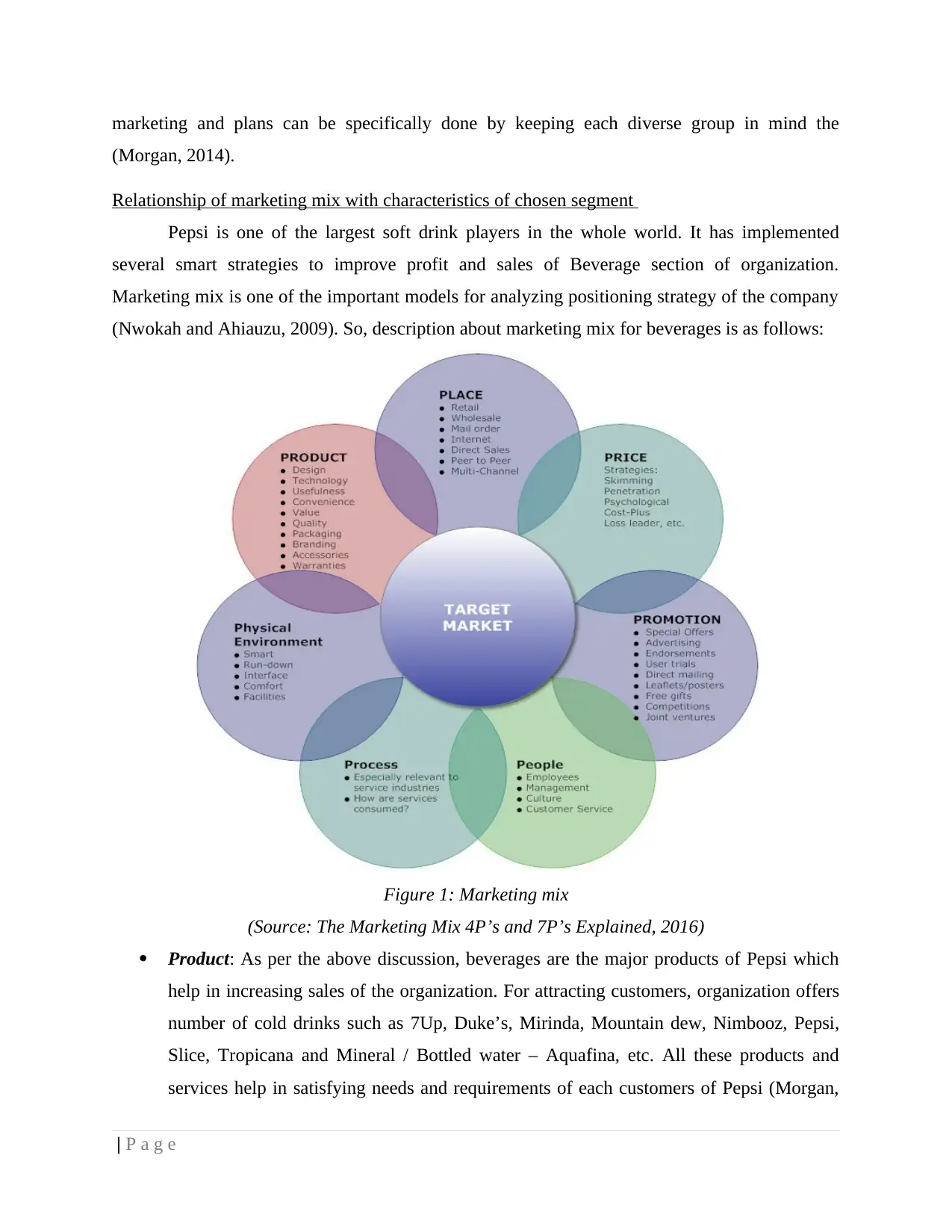
marketing and plans can be specifically done by keeping each diverse group in mind the
(Morgan, 2014).
Relationship of marketing mix with characteristics of chosen segment
Pepsi is one of the largest soft drink players in the whole world. It has implemented
several smart strategies to improve profit and sales of Beverage section of organization.
Marketing mix is one of the important models for analyzing positioning strategy of the company
(Nwokah and Ahiauzu, 2009). So, description about marketing mix for beverages is as follows:
Figure 1: Marketing mix
(Source: The Marketing Mix 4P’s and 7P’s Explained, 2016)
Product: As per the above discussion, beverages are the major products of Pepsi which
help in increasing sales of the organization. For attracting customers, organization offers
number of cold drinks such as 7Up, Duke’s, Mirinda, Mountain dew, Nimbooz, Pepsi,
Slice, Tropicana and Mineral / Bottled water – Aquafina, etc. All these products and
services help in satisfying needs and requirements of each customers of Pepsi (Morgan,
| P a g e
(Morgan, 2014).
Relationship of marketing mix with characteristics of chosen segment
Pepsi is one of the largest soft drink players in the whole world. It has implemented
several smart strategies to improve profit and sales of Beverage section of organization.
Marketing mix is one of the important models for analyzing positioning strategy of the company
(Nwokah and Ahiauzu, 2009). So, description about marketing mix for beverages is as follows:
Figure 1: Marketing mix
(Source: The Marketing Mix 4P’s and 7P’s Explained, 2016)
Product: As per the above discussion, beverages are the major products of Pepsi which
help in increasing sales of the organization. For attracting customers, organization offers
number of cold drinks such as 7Up, Duke’s, Mirinda, Mountain dew, Nimbooz, Pepsi,
Slice, Tropicana and Mineral / Bottled water – Aquafina, etc. All these products and
services help in satisfying needs and requirements of each customers of Pepsi (Morgan,
| P a g e
⊘ This is a preview!⊘
Do you want full access?
Subscribe today to unlock all pages.

Trusted by 1+ million students worldwide
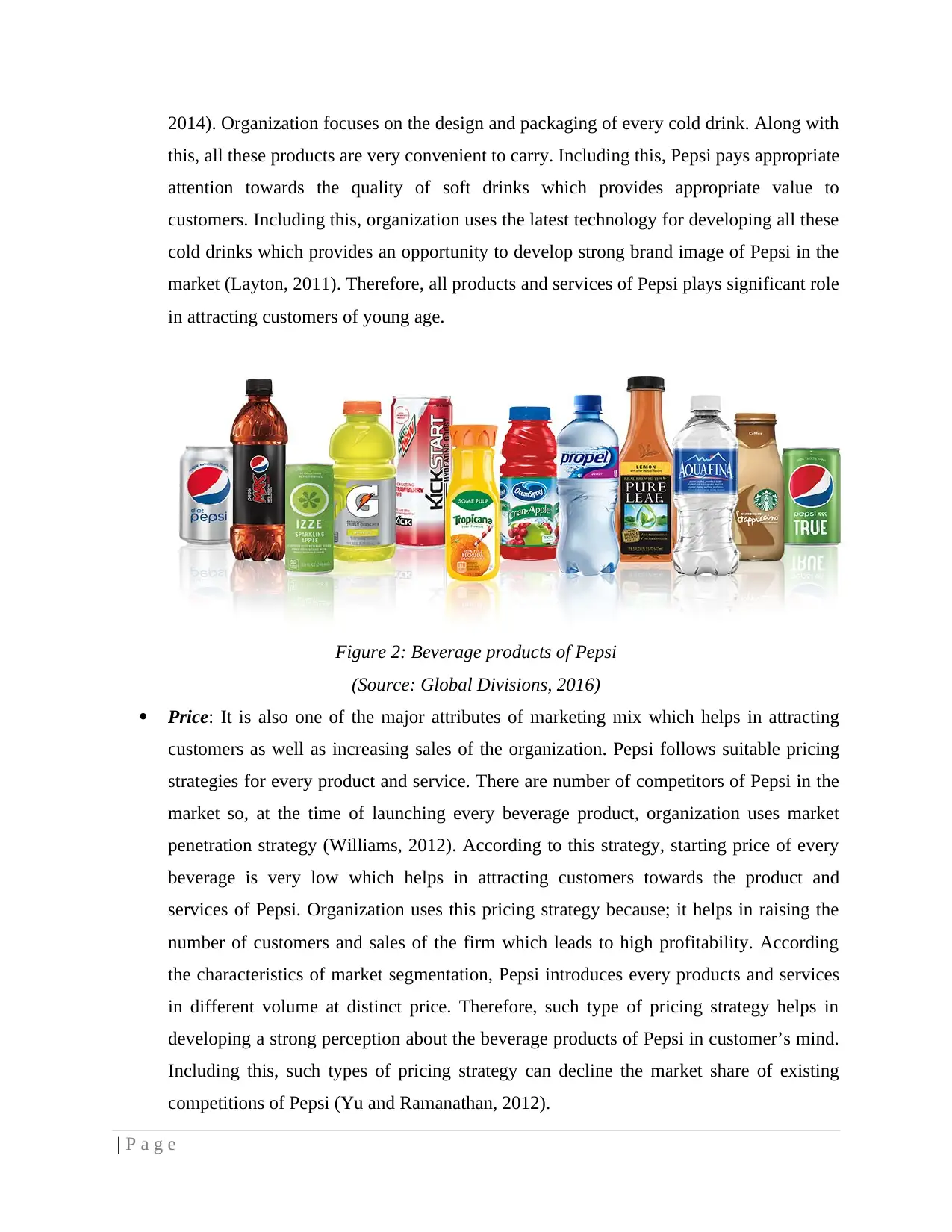
2014). Organization focuses on the design and packaging of every cold drink. Along with
this, all these products are very convenient to carry. Including this, Pepsi pays appropriate
attention towards the quality of soft drinks which provides appropriate value to
customers. Including this, organization uses the latest technology for developing all these
cold drinks which provides an opportunity to develop strong brand image of Pepsi in the
market (Layton, 2011). Therefore, all products and services of Pepsi plays significant role
in attracting customers of young age.
Figure 2: Beverage products of Pepsi
(Source: Global Divisions, 2016)
Price: It is also one of the major attributes of marketing mix which helps in attracting
customers as well as increasing sales of the organization. Pepsi follows suitable pricing
strategies for every product and service. There are number of competitors of Pepsi in the
market so, at the time of launching every beverage product, organization uses market
penetration strategy (Williams, 2012). According to this strategy, starting price of every
beverage is very low which helps in attracting customers towards the product and
services of Pepsi. Organization uses this pricing strategy because; it helps in raising the
number of customers and sales of the firm which leads to high profitability. According
the characteristics of market segmentation, Pepsi introduces every products and services
in different volume at distinct price. Therefore, such type of pricing strategy helps in
developing a strong perception about the beverage products of Pepsi in customer’s mind.
Including this, such types of pricing strategy can decline the market share of existing
competitions of Pepsi (Yu and Ramanathan, 2012).
| P a g e
this, all these products are very convenient to carry. Including this, Pepsi pays appropriate
attention towards the quality of soft drinks which provides appropriate value to
customers. Including this, organization uses the latest technology for developing all these
cold drinks which provides an opportunity to develop strong brand image of Pepsi in the
market (Layton, 2011). Therefore, all products and services of Pepsi plays significant role
in attracting customers of young age.
Figure 2: Beverage products of Pepsi
(Source: Global Divisions, 2016)
Price: It is also one of the major attributes of marketing mix which helps in attracting
customers as well as increasing sales of the organization. Pepsi follows suitable pricing
strategies for every product and service. There are number of competitors of Pepsi in the
market so, at the time of launching every beverage product, organization uses market
penetration strategy (Williams, 2012). According to this strategy, starting price of every
beverage is very low which helps in attracting customers towards the product and
services of Pepsi. Organization uses this pricing strategy because; it helps in raising the
number of customers and sales of the firm which leads to high profitability. According
the characteristics of market segmentation, Pepsi introduces every products and services
in different volume at distinct price. Therefore, such type of pricing strategy helps in
developing a strong perception about the beverage products of Pepsi in customer’s mind.
Including this, such types of pricing strategy can decline the market share of existing
competitions of Pepsi (Yu and Ramanathan, 2012).
| P a g e
Paraphrase This Document
Need a fresh take? Get an instant paraphrase of this document with our AI Paraphraser
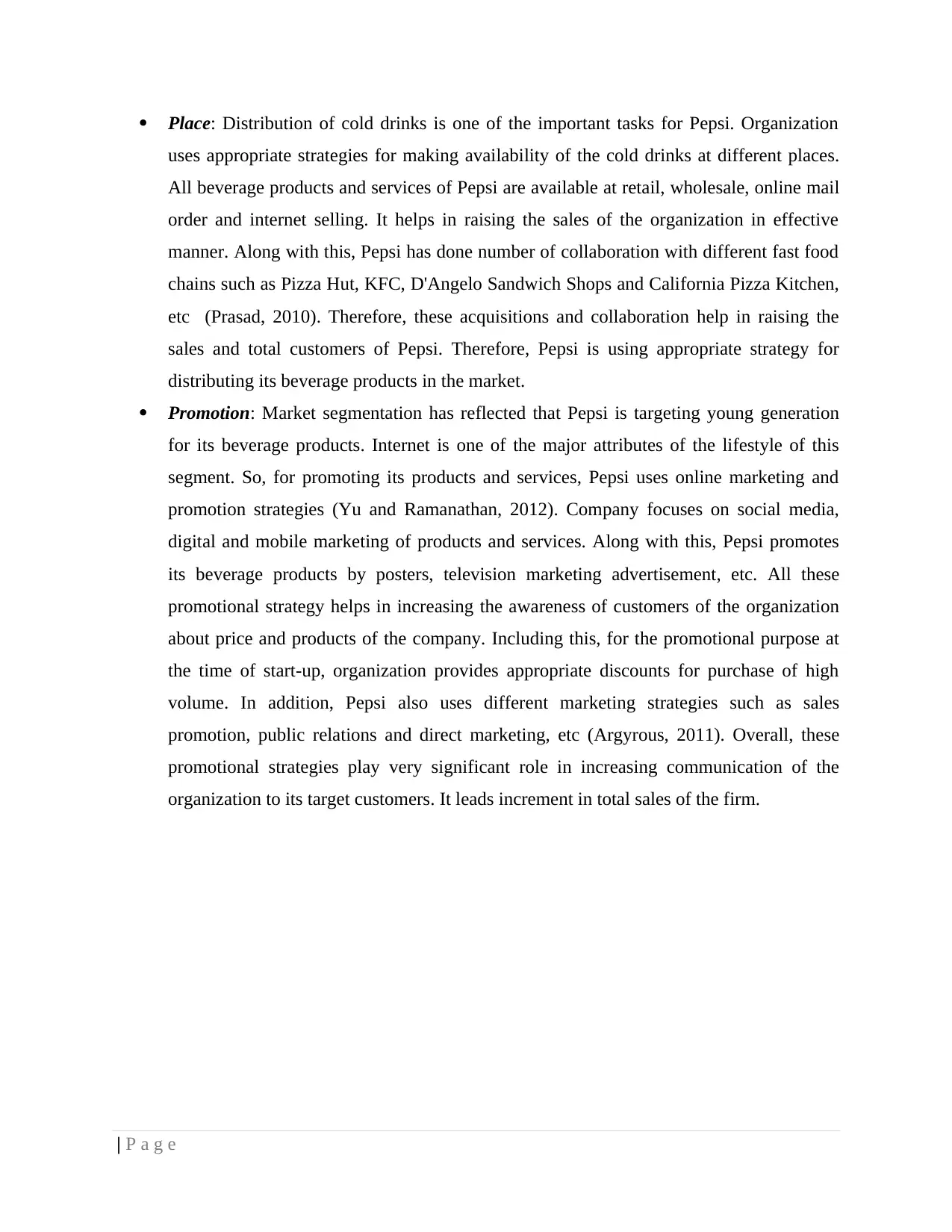
Place: Distribution of cold drinks is one of the important tasks for Pepsi. Organization
uses appropriate strategies for making availability of the cold drinks at different places.
All beverage products and services of Pepsi are available at retail, wholesale, online mail
order and internet selling. It helps in raising the sales of the organization in effective
manner. Along with this, Pepsi has done number of collaboration with different fast food
chains such as Pizza Hut, KFC, D'Angelo Sandwich Shops and California Pizza Kitchen,
etc (Prasad, 2010). Therefore, these acquisitions and collaboration help in raising the
sales and total customers of Pepsi. Therefore, Pepsi is using appropriate strategy for
distributing its beverage products in the market.
Promotion: Market segmentation has reflected that Pepsi is targeting young generation
for its beverage products. Internet is one of the major attributes of the lifestyle of this
segment. So, for promoting its products and services, Pepsi uses online marketing and
promotion strategies (Yu and Ramanathan, 2012). Company focuses on social media,
digital and mobile marketing of products and services. Along with this, Pepsi promotes
its beverage products by posters, television marketing advertisement, etc. All these
promotional strategy helps in increasing the awareness of customers of the organization
about price and products of the company. Including this, for the promotional purpose at
the time of start-up, organization provides appropriate discounts for purchase of high
volume. In addition, Pepsi also uses different marketing strategies such as sales
promotion, public relations and direct marketing, etc (Argyrous, 2011). Overall, these
promotional strategies play very significant role in increasing communication of the
organization to its target customers. It leads increment in total sales of the firm.
| P a g e
uses appropriate strategies for making availability of the cold drinks at different places.
All beverage products and services of Pepsi are available at retail, wholesale, online mail
order and internet selling. It helps in raising the sales of the organization in effective
manner. Along with this, Pepsi has done number of collaboration with different fast food
chains such as Pizza Hut, KFC, D'Angelo Sandwich Shops and California Pizza Kitchen,
etc (Prasad, 2010). Therefore, these acquisitions and collaboration help in raising the
sales and total customers of Pepsi. Therefore, Pepsi is using appropriate strategy for
distributing its beverage products in the market.
Promotion: Market segmentation has reflected that Pepsi is targeting young generation
for its beverage products. Internet is one of the major attributes of the lifestyle of this
segment. So, for promoting its products and services, Pepsi uses online marketing and
promotion strategies (Yu and Ramanathan, 2012). Company focuses on social media,
digital and mobile marketing of products and services. Along with this, Pepsi promotes
its beverage products by posters, television marketing advertisement, etc. All these
promotional strategy helps in increasing the awareness of customers of the organization
about price and products of the company. Including this, for the promotional purpose at
the time of start-up, organization provides appropriate discounts for purchase of high
volume. In addition, Pepsi also uses different marketing strategies such as sales
promotion, public relations and direct marketing, etc (Argyrous, 2011). Overall, these
promotional strategies play very significant role in increasing communication of the
organization to its target customers. It leads increment in total sales of the firm.
| P a g e
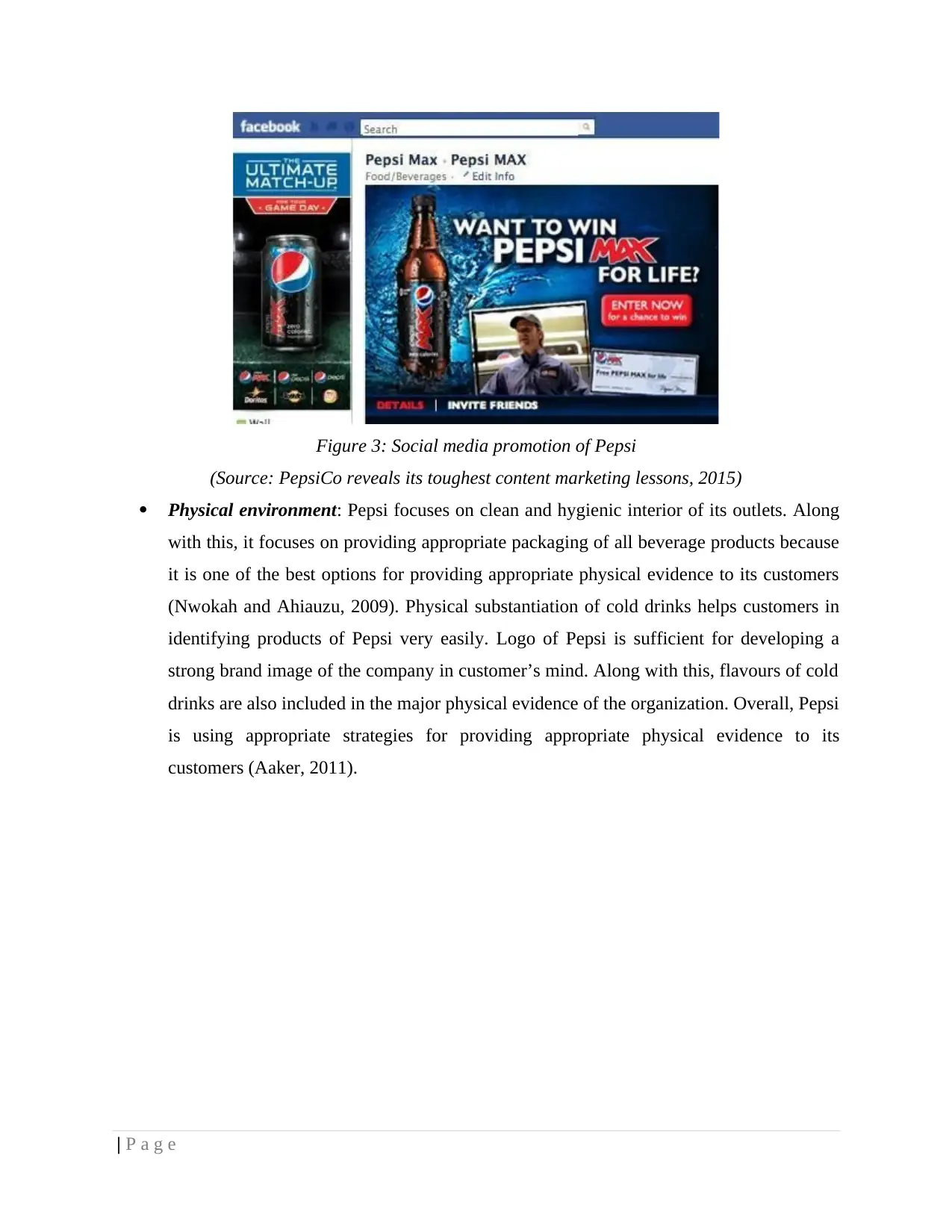
Figure 3: Social media promotion of Pepsi
(Source: PepsiCo reveals its toughest content marketing lessons, 2015)
Physical environment: Pepsi focuses on clean and hygienic interior of its outlets. Along
with this, it focuses on providing appropriate packaging of all beverage products because
it is one of the best options for providing appropriate physical evidence to its customers
(Nwokah and Ahiauzu, 2009). Physical substantiation of cold drinks helps customers in
identifying products of Pepsi very easily. Logo of Pepsi is sufficient for developing a
strong brand image of the company in customer’s mind. Along with this, flavours of cold
drinks are also included in the major physical evidence of the organization. Overall, Pepsi
is using appropriate strategies for providing appropriate physical evidence to its
customers (Aaker, 2011).
| P a g e
(Source: PepsiCo reveals its toughest content marketing lessons, 2015)
Physical environment: Pepsi focuses on clean and hygienic interior of its outlets. Along
with this, it focuses on providing appropriate packaging of all beverage products because
it is one of the best options for providing appropriate physical evidence to its customers
(Nwokah and Ahiauzu, 2009). Physical substantiation of cold drinks helps customers in
identifying products of Pepsi very easily. Logo of Pepsi is sufficient for developing a
strong brand image of the company in customer’s mind. Along with this, flavours of cold
drinks are also included in the major physical evidence of the organization. Overall, Pepsi
is using appropriate strategies for providing appropriate physical evidence to its
customers (Aaker, 2011).
| P a g e
⊘ This is a preview!⊘
Do you want full access?
Subscribe today to unlock all pages.

Trusted by 1+ million students worldwide
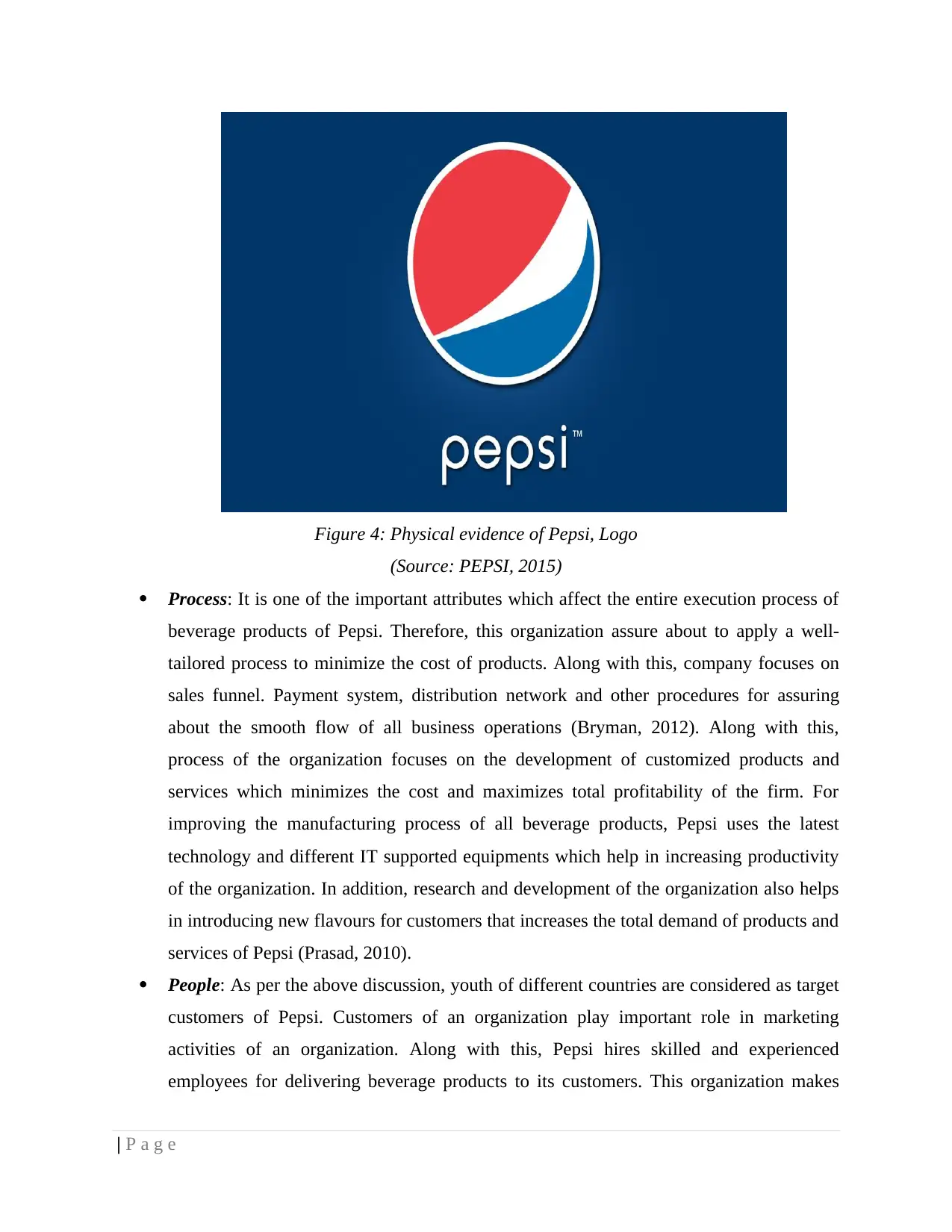
Figure 4: Physical evidence of Pepsi, Logo
(Source: PEPSI, 2015)
Process: It is one of the important attributes which affect the entire execution process of
beverage products of Pepsi. Therefore, this organization assure about to apply a well-
tailored process to minimize the cost of products. Along with this, company focuses on
sales funnel. Payment system, distribution network and other procedures for assuring
about the smooth flow of all business operations (Bryman, 2012). Along with this,
process of the organization focuses on the development of customized products and
services which minimizes the cost and maximizes total profitability of the firm. For
improving the manufacturing process of all beverage products, Pepsi uses the latest
technology and different IT supported equipments which help in increasing productivity
of the organization. In addition, research and development of the organization also helps
in introducing new flavours for customers that increases the total demand of products and
services of Pepsi (Prasad, 2010).
People: As per the above discussion, youth of different countries are considered as target
customers of Pepsi. Customers of an organization play important role in marketing
activities of an organization. Along with this, Pepsi hires skilled and experienced
employees for delivering beverage products to its customers. This organization makes
| P a g e
(Source: PEPSI, 2015)
Process: It is one of the important attributes which affect the entire execution process of
beverage products of Pepsi. Therefore, this organization assure about to apply a well-
tailored process to minimize the cost of products. Along with this, company focuses on
sales funnel. Payment system, distribution network and other procedures for assuring
about the smooth flow of all business operations (Bryman, 2012). Along with this,
process of the organization focuses on the development of customized products and
services which minimizes the cost and maximizes total profitability of the firm. For
improving the manufacturing process of all beverage products, Pepsi uses the latest
technology and different IT supported equipments which help in increasing productivity
of the organization. In addition, research and development of the organization also helps
in introducing new flavours for customers that increases the total demand of products and
services of Pepsi (Prasad, 2010).
People: As per the above discussion, youth of different countries are considered as target
customers of Pepsi. Customers of an organization play important role in marketing
activities of an organization. Along with this, Pepsi hires skilled and experienced
employees for delivering beverage products to its customers. This organization makes
| P a g e
Paraphrase This Document
Need a fresh take? Get an instant paraphrase of this document with our AI Paraphraser
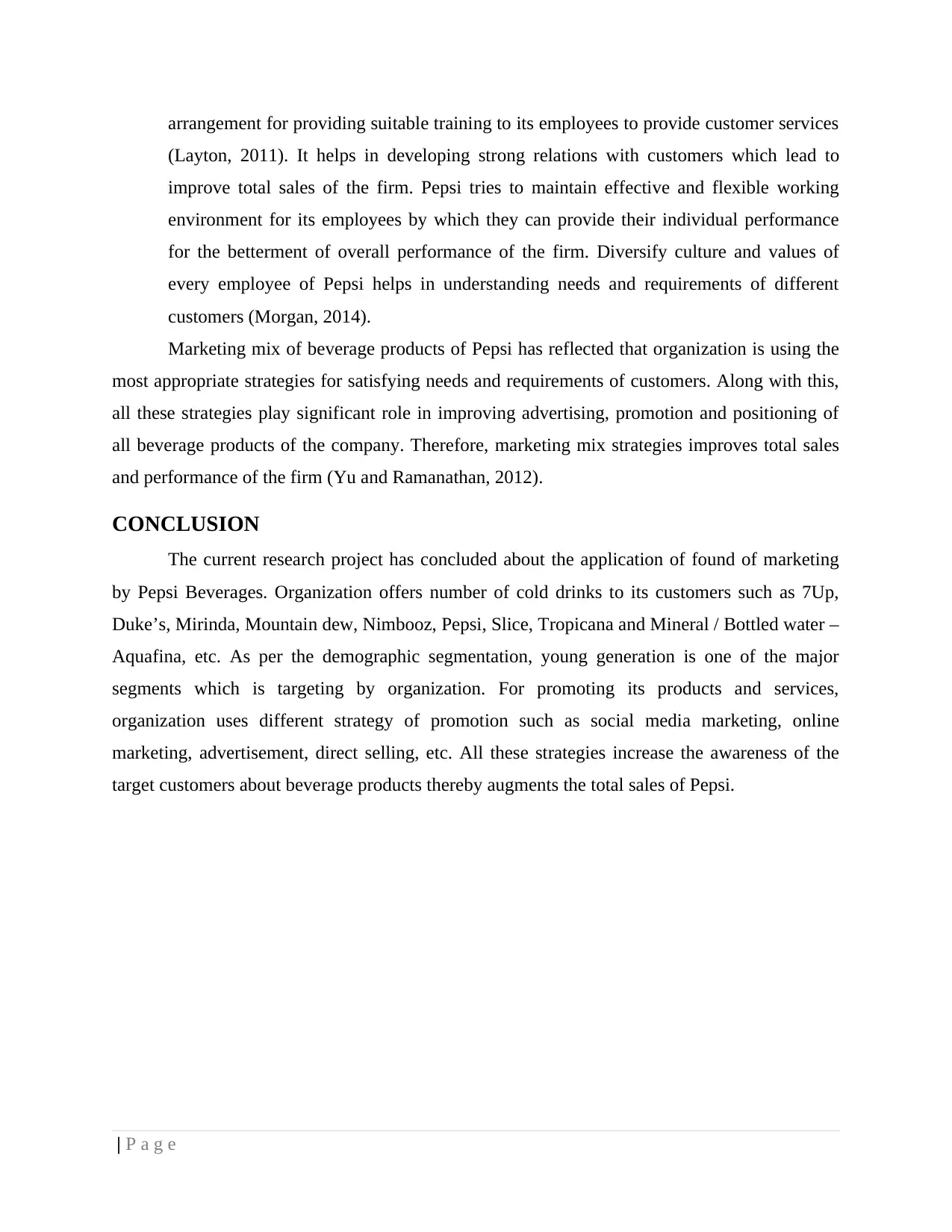
arrangement for providing suitable training to its employees to provide customer services
(Layton, 2011). It helps in developing strong relations with customers which lead to
improve total sales of the firm. Pepsi tries to maintain effective and flexible working
environment for its employees by which they can provide their individual performance
for the betterment of overall performance of the firm. Diversify culture and values of
every employee of Pepsi helps in understanding needs and requirements of different
customers (Morgan, 2014).
Marketing mix of beverage products of Pepsi has reflected that organization is using the
most appropriate strategies for satisfying needs and requirements of customers. Along with this,
all these strategies play significant role in improving advertising, promotion and positioning of
all beverage products of the company. Therefore, marketing mix strategies improves total sales
and performance of the firm (Yu and Ramanathan, 2012).
CONCLUSION
The current research project has concluded about the application of found of marketing
by Pepsi Beverages. Organization offers number of cold drinks to its customers such as 7Up,
Duke’s, Mirinda, Mountain dew, Nimbooz, Pepsi, Slice, Tropicana and Mineral / Bottled water –
Aquafina, etc. As per the demographic segmentation, young generation is one of the major
segments which is targeting by organization. For promoting its products and services,
organization uses different strategy of promotion such as social media marketing, online
marketing, advertisement, direct selling, etc. All these strategies increase the awareness of the
target customers about beverage products thereby augments the total sales of Pepsi.
| P a g e
(Layton, 2011). It helps in developing strong relations with customers which lead to
improve total sales of the firm. Pepsi tries to maintain effective and flexible working
environment for its employees by which they can provide their individual performance
for the betterment of overall performance of the firm. Diversify culture and values of
every employee of Pepsi helps in understanding needs and requirements of different
customers (Morgan, 2014).
Marketing mix of beverage products of Pepsi has reflected that organization is using the
most appropriate strategies for satisfying needs and requirements of customers. Along with this,
all these strategies play significant role in improving advertising, promotion and positioning of
all beverage products of the company. Therefore, marketing mix strategies improves total sales
and performance of the firm (Yu and Ramanathan, 2012).
CONCLUSION
The current research project has concluded about the application of found of marketing
by Pepsi Beverages. Organization offers number of cold drinks to its customers such as 7Up,
Duke’s, Mirinda, Mountain dew, Nimbooz, Pepsi, Slice, Tropicana and Mineral / Bottled water –
Aquafina, etc. As per the demographic segmentation, young generation is one of the major
segments which is targeting by organization. For promoting its products and services,
organization uses different strategy of promotion such as social media marketing, online
marketing, advertisement, direct selling, etc. All these strategies increase the awareness of the
target customers about beverage products thereby augments the total sales of Pepsi.
| P a g e
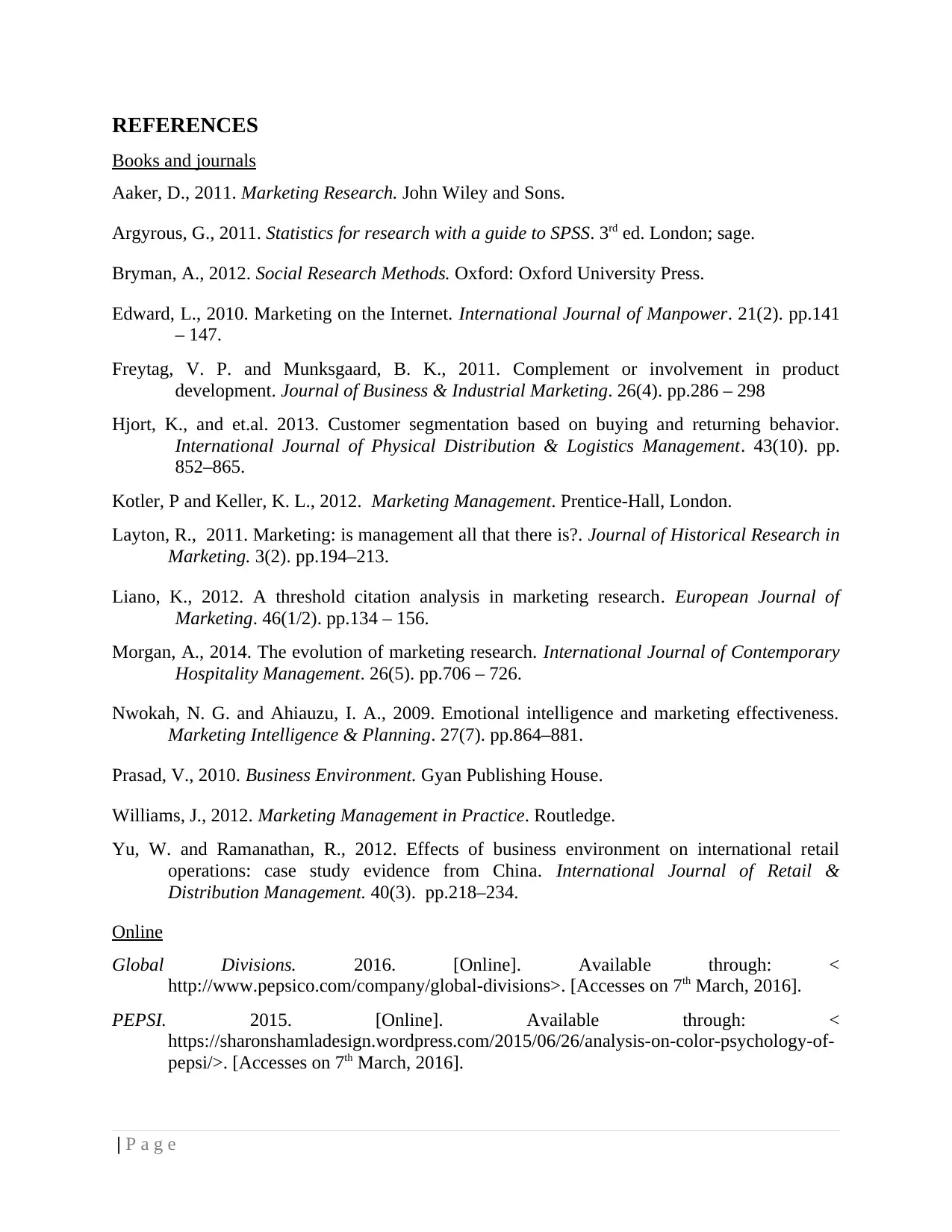
REFERENCES
Books and journals
Aaker, D., 2011. Marketing Research. John Wiley and Sons.
Argyrous, G., 2011. Statistics for research with a guide to SPSS. 3rd ed. London; sage.
Bryman, A., 2012. Social Research Methods. Oxford: Oxford University Press.
Edward, L., 2010. Marketing on the Internet. International Journal of Manpower. 21(2). pp.141
– 147.
Freytag, V. P. and Munksgaard, B. K., 2011. Complement or involvement in product
development. Journal of Business & Industrial Marketing. 26(4). pp.286 – 298
Hjort, K., and et.al. 2013. Customer segmentation based on buying and returning behavior.
International Journal of Physical Distribution & Logistics Management. 43(10). pp.
852–865.
Kotler, P and Keller, K. L., 2012. Marketing Management. Prentice-Hall, London.
Layton, R., 2011. Marketing: is management all that there is?. Journal of Historical Research in
Marketing. 3(2). pp.194–213.
Liano, K., 2012. A threshold citation analysis in marketing research. European Journal of
Marketing. 46(1/2). pp.134 – 156.
Morgan, A., 2014. The evolution of marketing research. International Journal of Contemporary
Hospitality Management. 26(5). pp.706 – 726.
Nwokah, N. G. and Ahiauzu, I. A., 2009. Emotional intelligence and marketing effectiveness.
Marketing Intelligence & Planning. 27(7). pp.864–881.
Prasad, V., 2010. Business Environment. Gyan Publishing House.
Williams, J., 2012. Marketing Management in Practice. Routledge.
Yu, W. and Ramanathan, R., 2012. Effects of business environment on international retail
operations: case study evidence from China. International Journal of Retail &
Distribution Management. 40(3). pp.218–234.
Online
Global Divisions. 2016. [Online]. Available through: <
http://www.pepsico.com/company/global-divisions>. [Accesses on 7th March, 2016].
PEPSI. 2015. [Online]. Available through: <
https://sharonshamladesign.wordpress.com/2015/06/26/analysis-on-color-psychology-of-
pepsi/>. [Accesses on 7th March, 2016].
| P a g e
Books and journals
Aaker, D., 2011. Marketing Research. John Wiley and Sons.
Argyrous, G., 2011. Statistics for research with a guide to SPSS. 3rd ed. London; sage.
Bryman, A., 2012. Social Research Methods. Oxford: Oxford University Press.
Edward, L., 2010. Marketing on the Internet. International Journal of Manpower. 21(2). pp.141
– 147.
Freytag, V. P. and Munksgaard, B. K., 2011. Complement or involvement in product
development. Journal of Business & Industrial Marketing. 26(4). pp.286 – 298
Hjort, K., and et.al. 2013. Customer segmentation based on buying and returning behavior.
International Journal of Physical Distribution & Logistics Management. 43(10). pp.
852–865.
Kotler, P and Keller, K. L., 2012. Marketing Management. Prentice-Hall, London.
Layton, R., 2011. Marketing: is management all that there is?. Journal of Historical Research in
Marketing. 3(2). pp.194–213.
Liano, K., 2012. A threshold citation analysis in marketing research. European Journal of
Marketing. 46(1/2). pp.134 – 156.
Morgan, A., 2014. The evolution of marketing research. International Journal of Contemporary
Hospitality Management. 26(5). pp.706 – 726.
Nwokah, N. G. and Ahiauzu, I. A., 2009. Emotional intelligence and marketing effectiveness.
Marketing Intelligence & Planning. 27(7). pp.864–881.
Prasad, V., 2010. Business Environment. Gyan Publishing House.
Williams, J., 2012. Marketing Management in Practice. Routledge.
Yu, W. and Ramanathan, R., 2012. Effects of business environment on international retail
operations: case study evidence from China. International Journal of Retail &
Distribution Management. 40(3). pp.218–234.
Online
Global Divisions. 2016. [Online]. Available through: <
http://www.pepsico.com/company/global-divisions>. [Accesses on 7th March, 2016].
PEPSI. 2015. [Online]. Available through: <
https://sharonshamladesign.wordpress.com/2015/06/26/analysis-on-color-psychology-of-
pepsi/>. [Accesses on 7th March, 2016].
| P a g e
⊘ This is a preview!⊘
Do you want full access?
Subscribe today to unlock all pages.

Trusted by 1+ million students worldwide
1 out of 13
Related Documents
Your All-in-One AI-Powered Toolkit for Academic Success.
+13062052269
info@desklib.com
Available 24*7 on WhatsApp / Email
![[object Object]](/_next/static/media/star-bottom.7253800d.svg)
Unlock your academic potential
Copyright © 2020–2025 A2Z Services. All Rights Reserved. Developed and managed by ZUCOL.




